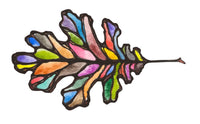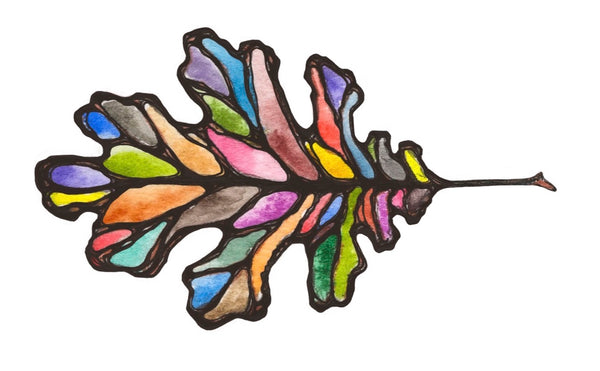Japanese Tiger's Eye Watercolor Paint, Quarter-Pan
Greenleaf & Blueberry Professional Handmade Watercolors
Color Overview
| Color Name | Japanese Tiger's Eye |
| Pigment | Japanese Tiger's Eye |
| Pigment Index No. | N/A |
| Chemical Formula | SiO₂ |
| Series No. | Series 8 |
| Lightfastness Rating | 5/5 Very Lightfast |
| Toxicity | 1/5 No Known Toxicity |
| Hue | Brown Category |
| Chroma | 2/5 Low to Moderate Chroma |
| Transparency | 3/5 Somewhat Opaque |
| Pigment Type | Natural |
| Granulation | Some |
| Value Range | 3/5 Moderate Range |
| Tinting Strength | 3/5 Moderate Strength |
| Staining | Low Staining |
| Flocculation | 2/5 Dispersing |
| Variegation | Some |
| Combination Swatch |
|
| Gravity Wash Swatch |
|
| Value Scale Swatch |
|
Color Description
Our Japanese Tiger's Eye displays a lovely warm brown hue. Its characteristics are reminiscent of the smoothness of Ochre pigments, but with a little more flair. There is a hint of granulation and variegation you will notice in some applications. Fine particle size and even application make this color relatively easy to control.
This color can add subtle warmth to mixtures and landscapes.
Each of the following swatches have been painted onto Arches Cold Pressed 140 lb. watercolor paper.
Color Story
Tiger's Eye is a type of quartz that formed with parallel striations that over time have been replaced by iron oxide while retaining their structure, which causes the waving and dancing light bands that make Tiger's Eye instantly recognizable.
Amber and golden colored Tiger's Eye predominantly receives its color from iron oxides, in particular: Limonite.
Unfortunately, the structure that causes the dancing light is destroyed when the rock is turned into pigment. However, this is a color that conceals some surprises, such as subtle variegation and granulation.
To learn more about iron oxides, read our post about them here.
While Tiger's Eye is a stone that has had a variety of uses since antiquity, it has never been commonly used as an artist's pigment.
Swatches
Color behavior assessments and descriptions are of course somewhat subjective, your perception being determined by your watercoloring experience. We offer this information with the intent of giving you an accurate idea of how a color will look and handle so that you can determine if it is a good fit for your palette and painting practice.
Combination Swatch:

This swatch demonstrates:
- Opacity: Compare the two black lines, the top lines is drawn over the swatch and the bottom one is under the swatch. The more the bottom line has disappeared, the more opaque the color.
- Staining: The white line at the bottom of the swatch was lifted out. The whiter the line, the less staining the color.
- Value Range: Color is painted from most concentrated (at left) to least concentrated at right. The closer a color is to black at most concentrated, the wider its value range. (All watercolors painted onto white paper can be diluted to complete transparency, or white.)
Gravity Wash Swatch:

This swatch demonstrates:
(A Gravity Wash Swatch is made by pre-wetting the paper, then holding it vertically at an angle, and applying paint from left to right at the very top of the wetted area.)
-
Granulation: Granulation display is influenced both by pigment particle size and behavior determined by chemical composition. Granulating colors are recognizable in Gravity Washes through their patterned and textured appearance.
-
Flocculation: Flocculation is the tendency for a color's pigment particles to cling together or be attracted to one another. Dispersion is the opposite. A flocculating color is recognizable in a Gravity Wash by a "jellyfish" appearance with the downward movement of the pigment resembling tentacles, while a dispersing color more resembles a distant rainstorm, as is the case with French Red Ochre.
-
Variegation: Variegation is the tendency for a color's pigment to express itself as more than one hue, usually as a result of a range of pigment particle sizes. In a Gravity Wash, pigment particles have an opportunity to settle by size a bit, with the smaller particles getting carried further to the edges of where the color travels. If you only notice one hue in a gravity wash, then it is likely not a variegating color.
- Tinting Strength: It can be difficult to determine tinting strength in controlled color swatches. Because Gravity Washes are less controlled, you can get a more unvarnished look at a color, enabling you to assess characteristics you usually only catch glimpses of when painting. Colors that appear very dark, intense, and that cover more of the wash area have a more intense tinting strength, while colors that appear more faint and taper out before reaching the bottom of the swatch have a weaker tinting strength. We have rated French Red Ochre as moderate tinting strength (3/5), though it can be argued that it is closer to a 4.
Value Scale Swatch:
This swatch is painted in layers, starting with the lightest/least concentrated, and letting each layer dry before the next more concentrated layer is added. The leftmost and most concentrated layer is applied at a maximum concentration, which is generally not how watercolors are most often used, however this swatch is designed to display the full value range of a color.

This swatch demonstrates:
Value Range: Value range is a colors range from darkest (most concentrated) to lightest (least concentrated/most diluted). Value range is arguably one of the most important aspects of any watercolor. This type of swatch allows you to hold up a magnifying glass to that characteristic.
Our Pans
We work with metal Quarter-Pans. They are made of steel, and will therefore stick to magnets. As described by the name, these pans hold half the volume of paint as a Half-Pan, and one quarter the volume of paint as a Full Pan.
Quarter-Pans measure: Length: 1", Width: 1/2", Height: 1/8"
All of the metal pans we work with are designed and manufactured by Art Toolkit, specifically for watercolor painting.
Quarter-Pans are compatible with our Travel Palettes in Pocket Palette and Micro Palette sized, which are Art ToolkitPocket Palettes & Demi Palettes. These palettes are extremely lightweight and packable palettes (about the size of a business card). They are an excellent way to justify carrying along a color palette, no matter where your journey will be taking you.
More Information
- Overview of Pigments
- What Makes Our Colors Different
- How To Pick Colors & Create Your Perfect Watercolor Palette
Other Items You Might Find Useful For Watercolor Painting
Please be aware that every monitor and screen displays colors a little differently. We have done our very best to show our colors as they appear in person and on paper.
**Please Note**: These colors are NOT intended for children. Half-Pans are small and therefore a choking hazard. Please use only as intended.
All images and descriptions are copyrighted by Greenleaf & Blueberry®
© Greenleaf & Blueberry LLC 2011-2023









